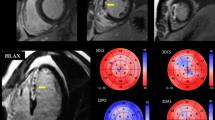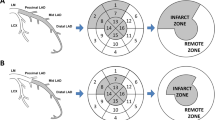Abstract
To investigate the impact of microvascular dysfunction assessed by angiography on myocardial deformation assessed by two-dimensional speckle-tracking echocardiography in ST-segment elevation myocardial infarction (STEMI). A total of 121 STEMI patients who received primary percutaneous coronary intervention were included. Thrombolysis in myocardial infarction, Myocardial Perfusion Frame Count (TMPFC), a novel angiographic method to assess myocardial perfusion, was used to evaluate microvascular dysfunction. Two-dimensional speckle-tracking echocardiography was performed at 3–7 days after reperfusion. The infarction related regional longitudinal (RLS) strains as well as circumferential (RCS) and radial (RRS) ones, along with global longitudinal, circumferential (GCS), and radial (GRS) strains were measured. Patients with microvascular dysfunction had decreased peak amplitude of RLS (p = 0.012), RCS (p < 0.001), RRS (p = 0.012) at the regional level and decreased peak amplitude of GCS (p = 0.005), GRS (p = 0.012) at the global level. The RCS to RLS and RCS to RRS ratios were significantly different between patients without than with microvascular dysfunction (1.28 ± 0.31 vs. 1.07 ± 0.47, p = 0.027 and 0.69 ± 0.33 vs. 0.56 ± 0.28, p = 0.047). Receiver operator characteristics curves identified a cutoff value of 94 frames for TMPFC to differentiate between normal and abnormal wall motion score index in the sub-acute phase of STEMI (AUC = 0.72; p < 0.001). In the sub-acute phase of STEMI, the presence of microvascular dysfunction in infarcted tissue relates to reduced global and regional myocardial deformation. RCS alterations were more significant than RLS and RRS between patients with than without microvascular dysfunction. TMPFC was useful to predict left ventricular systolic dysfunction in the sub-acute phase of STEMI.






Similar content being viewed by others
References
Yang Y, Sun Y, Yi W et al (2014) A review of melatonin as a suitable antioxidant against myocardial ischemia-reperfusion injury and clinical heart diseases. J Pineal Res 57:357–366
Huang B, Wang X, Yang Y et al (2015) Association of admission glycaemia with high grade atrioventricular block in ST-segment elevation myocardial infarction undergoing reperfusion therapy: an observational study. Medicine (Baltimore) 94:e1167
Pu J, Shan P, Ding S et al (2011) Gender differences in epicardial and tissue-level reperfusion in patients undergoing primary angioplasty for acute myocardial infarction. Atherosclerosis 215:203–208
Ding S, Li Z, Ge H et al (2015) Impact of early ST-segment changes on cardiac magnetic resonance-verified intramyocardial haemorrhage and microvascular obstruction in ST-elevation myocardial infarction patients. Medicine (Baltimore) 94:e1438
Ding S, Pu J, Qiao ZQ et al (2010) TIMI myocardial perfusion frame count: a new method to assess myocardial perfusion and its predictive value for short-term prognosis. Catheter Cardiovasc Interv 75:722–732
Gibson CM, Cannon CP, Murphy SA et al (2000) Relationship of TIMI myocardial perfusion grade to mortality after administration of thrombolytic drugs. Circulation 101:125–130
Van’t Hof AW, Liem A, Suryapranata H et al (1998) Angiographic assessment of myocardial reperfusion in patients treated with primary angioplasty for acute myocardial infarction: myocardial blush grade: Zwolle Myocardial Infarction Study Group. Circulation 97:2302–2306
Pu J, Shan PR, Ding S et al (2011) Factors affecting thrombolysis in myocardial infarction myocardial perfusion frame count: insights of myocardial tissue-level reperfusion from a novel index for assessing myocardial perfusion. Chin Med J (Engl) 124:873–878
Pu J, Ding S, Shan P et al (2010) Comparison of epicardial and myocardial perfusions after primary coronary angioplasty for ST-elevation myocardial infarction in patients under and over 75 years of age. Aging Clin Exp Res 22:295–302
Vitarelli A, Martino F, Capotosto L et al (2014) Early myocardial deformation changes in hypercholesterolemic and obese children and adolescents: a 2D and 3D speckle tracking echocardiography study. Medicine (Baltimore) 93:e71
Antoni ML, Mollema SA, Delgado V et al (2010) Prognostic importance of strain and strain rate after acute myocardial infarction. Eur Heart J 31:1640–1647
Thygesen K, Alpert JS, White HD et al (2007) Universal definition of myocardial infarction. Circulation 116:2634–2653
Conti CR, Feldman RL, Pepine CJ et al (1983) Effect of glyceryl trinitrate on coronary and systemic hemodynamics in man. Am J Med 74:28–32
Simes RJ, Topol EJ, Holmes DR Jr et al (1995) Link between the angiographic substudy and mortality outcomes in a larger and randomized trial of myocardial reperfusion. Importance of early and complete infarct artery reperfusion. GUSTO-I investigators. Circulation 91:1923–1928
Gibson CM, Murphy SA, Rizzo MJ et al (1999) Relationship between TIMI frame count and clinical outcomes after thrombolytic administration. Thrombolysis in Myocardial Infarction (TIMI) Study Group. Circulation 99:1945–1950
Ge H, Ding S, An D et al (2015) Frame counting improves the assessment of post-reperfusion microvascular patency by TIMI myocardial perfusion grade: evidence from cardiac magnetic resonance imaging. Int J Cardiol 203:360–366
Cheitlin MD, Alpert JS, Armstrong WF et al (1997) ACC/AHA guidelines for the clinical application of echocardiography. A report of the American College of Cardiology/American Heart Association Task Force on Practice Guidelines (Committee on Clinical Application of Echocardiography). Developed in collaboration with the American Society of Echocardiography. Circulation 95:1686–1744
Lang RM, Bierig M, Devereux RB et al (2005) Chamber Quantification Writing Group, American Society of Echocardiography’s Guidelines and Standards Committee, European Association of Echocardiography: recommendations for chamber quantification: a report from the American Society of Echocardiography’s Guidelines and Standards Committee and the Chamber Quantification Writing Group, developed in conjunction with the European Association of Echocardiography, a branch of the European Society of Cardiology. J Am Soc Echocardiogr 18:1440–1463
Jia EZ, Chen ZH, An FH et al (2014) Relationship of renin-angiotensin-aldosterone system polymorphisms and phenotypes to mortality in Chinese coronary atherosclerosis patients. Sci Rep 4:4600
Li J, Ma T, Mohar D et al (2015) Ultrafast optical-ultrasonic system and miniaturized catheter for imaging and characterizing atherosclerotic plaques in vivo. Sci Rep 5:18406
Xu TY, Sun JP, Lee AP et al (2015) Left atrial function as assessed by speckle-tracking echocardiography in hypertension. Medicine (Baltimore) 94:e526
Pirat B, Khoury DS, Hartley CJ et al (2008) A novel feature-tracking echocardiographic method for the quantitation of regional myocardial function: validation in an animal model of ischemia-reperfusion. J Am Coll Cardiol 51:651–659
Munk K, Andersen NH, Nielsen SS et al (2011) Global longitudinal strain by speckle tracking for infarct size estimation. Eur J Echocardiogr 12:156–165
Mistry N, Beitnes JO, Halvorsen S et al (2011) Assessment of left ventricular function in ST-elevation myocardial infarction by global longitudinal strain: a comparison with ejection fraction, infarct size, and wall motion score index measured by non-invasive imaging modalities. Eur J Echocardiogr 12:678–683
Jones CJ, Raposo L, Gibson DG (1990) Functional importance of the long axis dynamics of the human left ventricle. Br Heart J 63:215–220
Greenbaum RA, Ho SY, Gibson DG, Becker AE, Anderson RH (1981) Left ventricular fibre architecture in man. Br Heart J 45:248–263
Carasso S, Agmon Y, Roguin A et al (2013) Left ventricular function and functional recovery early and late after myocardial infarction: a prospective pilot study comparing two-dimensional strain, conventional echocardiography, and radionuclide myocardial perfusion imaging. J Am Soc Echocardiogr 26:1235–1244
Chan J, Hanekom L, Wong C et al (2006) Differentiation of subendocardial and transmural infarction using two-dimensional strain rate imaging to assess short-axis and long-axis myocardial function. J Am Coll Cardiol 48:2026–2033
Acknowledgments
This work was supported by National Natural Science Foundation of China (81270282, 81330006 and 81400261), Shanghai Leading Talents Program (LJ10007), Program for New Century Excellent Talents in University from Ministry of Education of China (NCET-12-0352), Shanghai Shuguang Program (12SG22), Program of Shanghai Committee of Science and Technology (15411963600 and 14JC1404500), Shanghai Emerging Technology Program (SHDC12013119), Shanghai Municipal Education Commission Gaofeng Clinical Medicine Grant Support (20152209), Shanghai Jiaotong University (YG2013MS420) and Shanghai Jiaotong University School of Medicine (15ZH1003 and 14XJ10019).
Author information
Authors and Affiliations
Corresponding author
Ethics declarations
Conflict of interest
There is no potential conflict of interest.
Rights and permissions
About this article
Cite this article
He, B., Ding, S., Qiao, Z. et al. Influence of microvascular dysfunction on regional myocardial deformation post-acute myocardial infarction: insights from a novel angiographic index for assessing myocardial tissue-level reperfusion. Int J Cardiovasc Imaging 32, 711–719 (2016). https://doi.org/10.1007/s10554-015-0834-4
Received:
Accepted:
Published:
Issue Date:
DOI: https://doi.org/10.1007/s10554-015-0834-4




